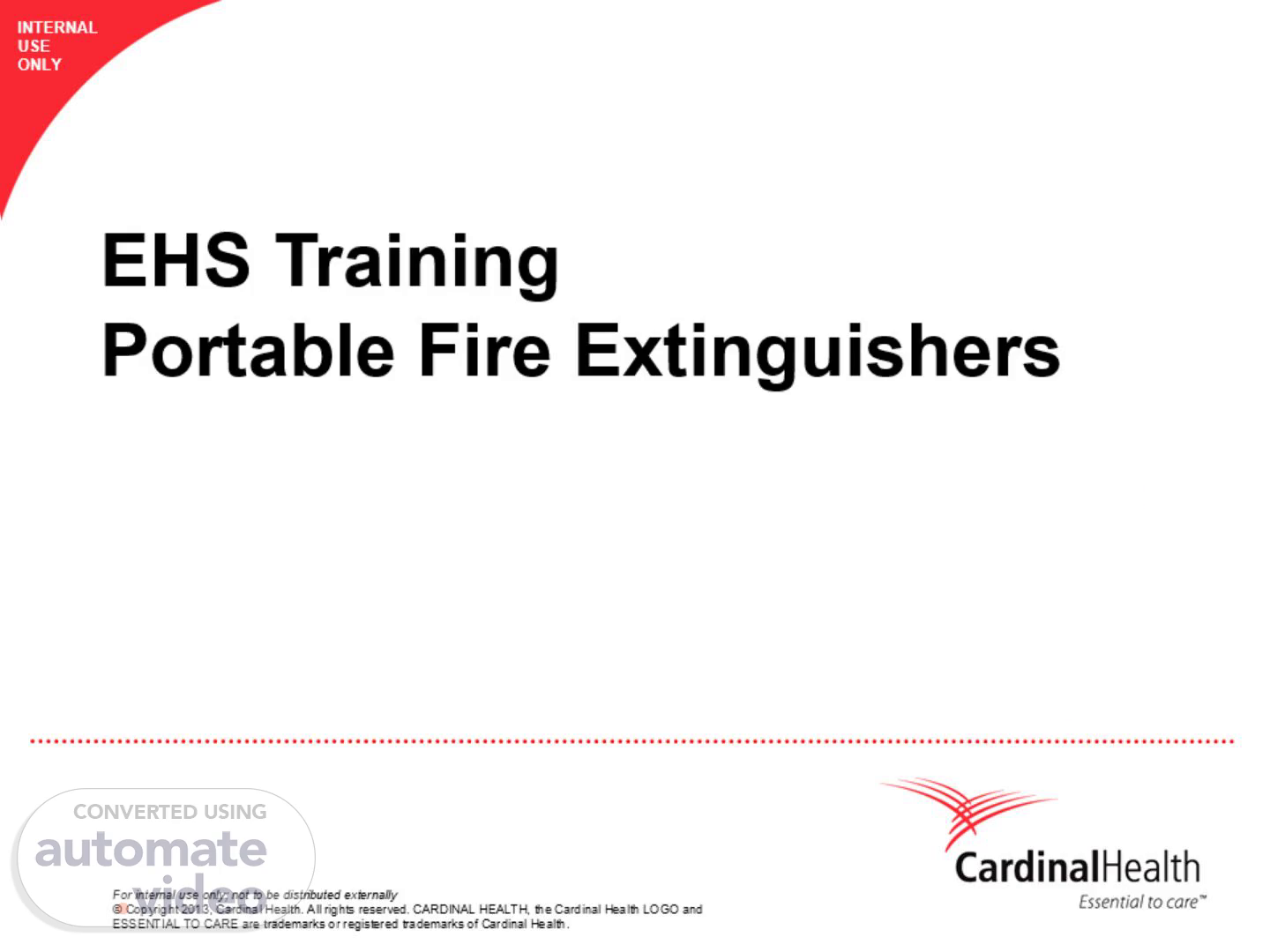Page 1 (0s)
[Audio] CAR-021 InternalUse_title.jpg Internal Use only EHS Training Portable Fire Extinguishers Portable Fire Extinguishers December 4, 2024.
Page 8 (3m 49s)
[Audio] Fire Extinguishers should be appropriately matched to work environment. Use the symbols to quickly identify the Type of Fire Extinguisher. 6 Types of Fire Extinguishers Class A – Wood, Paper, Plastics Class AB – Wood, Paper and Flammable Liquid Class BC (flammable liquid and electrical) Class ABC Multipurpose Class K – Kitchen Fire Class D – Metal Fires.
Page 9 (4m 24s)
[Audio] Learn to become aware of your surrounding…what’s in the room?.
Page 10 (4m 32s)
[Audio] Lamp - Electrical Plastic Chair – Fuel Computer - Electrical Paper - Fuel Electrical Socket Phone - Electrical Wood Desk - Fuel.
Page 11 (4m 44s)
[Audio] Type: Class A Fire Extinguisher Pressure Gauge: Yes Agent: Water Method: Water Cools fire by removing heat. Designated for: Class A (wood, paper, cloth, rubber, and certain plastics. Placement: 75 feet or less Safety and Health Precautions: Never use water to extinguish flammable liquid fires. Never use on Metal Fire (water reactive). Water is a good conductor and may lead to electrocution if used to extinguish an electrical fire..
Page 12 (5m 21s)
[Audio] Type: BC Fire Extinguisher Pressure Gauge: No (Must be weighed to determine leakage) Agent: Carbon dioxide is discharged as a white cloud of “snow” Method: Removes oxygen from fire Designated for: Class B and C (flammable liquid and electrical) fires only Placement: 50 feet or less Health and Safety Precautions: Carbon Dioxide is a clean, non-contaminating, odorless gas. After the CO2 dissipates, Class A fire may reignite. Never use CO2 extinguishers in a confined space.
Page 13 (6m 3s)
[Audio] Type: Multipurpose / ABC Dry Chemical Pressure Gauge Yes Agent: Mono ammonium phosphate, non-conductive, mildly corrosive Method: Fire retardant powder separates the fuel from the oxygen. Designated for: Wood, paper, Flammable Liquid, & Electrical Fire Placement: < 50 feet (based on B or C fire) Safety and Health Precautions: Mildly Corrosive – Sensitive to Electronic Equipment ABC Fire Extinguisher is the most common Fire Extinguisher and it’s the Fire Extinguisher primary used at Cardinal Health..
Page 14 (6m 29s)
[Audio] General Procedures for Responding To a Fire SOUND THE FIRE ALARM and call the fire department, if appropriate. IDENTIFY A SAFE EVACUATION PATH before approaching the fire. Do not allow the fire, heat, or smoke to come between you and your evacuation path. SELECT the appropriate type of fire extinguisher. DISCHARGE the extinguisher within its effective range using the P.A.S.S. technique (pull, aim, squeeze, sweep). BACK AWAY from an extinguished fire in case it flames up again. EVACUATE IMMEDIATELY if the extinguisher is empty and the fire is not out. EVACUATE IMMEDIATELY if the fire progresses beyond the incipient stage..
Page 15 (7m 15s)
[Audio] When it is Safe to Fight a Fire FIRE Is the Fire too Big? Fire has not spread Beyond point of origin. Flames are not higher than your head and you can safely approach the FIRE (room temperature is only slightly increased). AIR Is the AIR safe to Breath? Smoke may be accumulating on the ceiling, but you can see the fire clearly. Respiratory Protection is not needed. EVACUATION PATH Is there a Safe Evacuation Path? You have a clear, unobstructed path behind you as you fight the fire. You know where you are and how to safely EXIT the building..
Page 16 (7m 58s)
[Audio] “P”ULL... Pull the pin. This will also break the tamper seal. “A”IM... Aim low, pointing the extinguisher nozzle (or its horn or hose) at the base of the fire. Note: Do not touch the plastic discharge horn on CO2 extinguishers, it gets very cold and may damage skin. “S”QUEEZE... Squeeze the handle to release the extinguishing agent. “S”WEEP... Sweep from side to side at the base of the fire until it appears to be out. Watch the area. If the fire re-ignites, repeat steps 2 - 4. If you have the slightest doubt about your ability to fight a fire....EVACUATE IMMEDIATELY!.
Page 17 (8m 42s)
[Audio] Monthly Inspection Is the Fire Extinguisher in its designated place? No obstruction to access or visibility? Pressure gauge reading or indicator in operable range or position? Fire Extinguishers must be easily accessible, inspected periodically, the tamper seal must be intact, and the gauge nozzle should be in the green..
Page 18 (9m 4s)
[Audio] Monthly Inspection (cont.) Cylinder Shell Corrosion Mechanical Damage (dent abrasion) Paint Condition Presence of repairs (welds, soldering) Damaged Threads Broken Hanger attachment Broken Handle Lug.
Page 19 (9m 22s)
[Audio] Name plate, instructions, and pull ring Illegible Wording Corrosion or loose plate Verifying operating instructions on nameplates are legible and face outward. Broken, missing safety seals and tamper indicators..
Page 20 (9m 37s)
[Audio] Nozzle or Horn Deformed, Damaged or Cracked Blocked opening Damaged threads Hose obstruction Hydrostatic test date.
Page 21 (9m 50s)
[Audio] Portable Fire Extinguishers Pressure indicating device Immovable, jammed, missing pointer Deformed, or broken crystal Illegible or faded dial Corrosion Dented case or crystal retainer Immovable or corroded pressure indicating stem.
Page 22 (10m 8s)
[Audio] Portable Fire Extinguishers Documenting the monthly inspection Document the inspection on a tag attached to the neck of the extinguisher. Document the date and the initials of the inspector..
Page 23 (10m 26s)
[Audio] Maintenance Annually Hydrostatic Testing Refer to Table L-1 for hydrostatic testing interval dates. Testing must be performed by someone with suitable testing and equipment facilities. Retain certification record for all testing. Utilize a 3rd party for Annual maintenance check. Ensure you have adequate protection when fire extinguishers are removed for maintenance or recharging..
Page 24 (10m 52s)
[Audio] Questions?. 24. Questions?.
